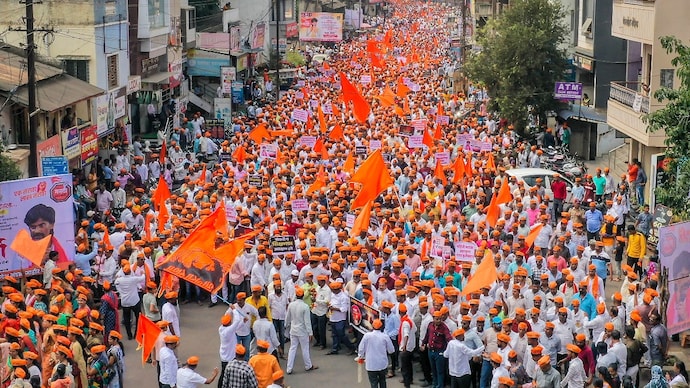What is coming in way of Maratha reservation? Maharashtra quota issue explained
The agitation for Maratha reservation has again gained momentum and Maharashtra Chief Minister Eknath Shinde has reiterated his support for the quota. But what is the Marathi quota issue and what is coming in its way? Here's all you need to know.

The longstanding demand for reservations for Marathas in education and jobs in Maharashtra has got fresh energy with quota activist Manoj Jarange Patil on a hunger strike for more than a week now. Violence also erupted during the agitation with houses of several MLAs being set on fire.
On Wednesday, Maharashtra Chief Minister Eknath Shinde reiterated that his government was for the Maratha quota.
Who are the Marathas and why are they seeking reservation? And if the state government is in favour of reservation for them, what is coming in the way of the Maratha quota? Here’s an explainer to help understand the issue.
THE BASICS FIRST: MARATHAS AND MARATHIS
Marathas are said to form 33 per cent of Maharashtra's population. From landowners to peasants to warriors, they cover a range of castes.
The Maratha Kshatriyas have surnames like Deshmukh, Bhonsle, More, Shirke and Jadhav. Most others belong to Kunbi, a predominantly agrarian sub-caste.
The Kshatriya-Kunbi difference existed till the days of the Maratha empire. Now, most Marathas are engaged in farming activities.
While all Marathas are Marathis, not all Marathis are Marathas. Maratha signifies a group of castes, while Marathi is the language spoken by several communities in Maharashtra and some neighbouring areas of other states.
A maximal circle of 96 clans is said to include all true Maratha, but the lists of these 96 clans are highly varied and disputed.
WHY THE DEMAND FOR MARATHA QUOTA?
Forming around 33 per cent of Maharashtra's population, Marathas are one of the biggest communities in India. They have a huge sway on the state's and national politics.
Maharashtra had Marathas as chief ministers for 31 years. However, it has to be remembered that Marathas are predominantly farmers with small land holdings of less than 2 hectare.
With low yields from the small landholdings and often hit by droughts, it is largely the agrarian Maratha facing farm distress who seeks reservation. That is why the Marathwada region has emerged as the epicentre of the Maratha caste agitation.
The government is likely to give reservations to Marathas of the Marathwada region by giving them Kunbi certificates. But quota activist Manoj Jarange Patil says the stir will not end till all Marathas in Maharashtra get reservation benefits.
THE LONG FIGHT FOR MARATHA RESERVATION
The first protest on reservations for Marathas took place in 1982. The protest was led by labour union leader Annasaheb Patil and his demand was quotas on the basis of economic criteria.
Annasaheb Patil had threatened that he would die by suicide if his demands weren’t met. The Congress government of Babasaheb Bhosale turned a deaf ear to him and Annasaheb Patil carried out his threat.
That was the first death related to the protracted fight for the Maratha reservation.
The demand for reservations on economic grounds started changing to quotas on caste lines after the Mandal Commission report of 1990.
In 2004, the Maharashtra government included Maratha-Kunbis and Kunbi-Marathas in the list of other backward classes (OBCs) but left out those who identified as Marathas. Kunbis were already classified as OBCs.
Maratha leaders demanded that their community be included in the list of OBCs. Certain groups opposed the demand as they argued that inclusion of the “powerful” Maratha community would eat into their share. The protests for Maratha quotas gained momentum in 2016.
In 2014, a panel headed by then Maharashtra CM Narayan Rane recommended 16 per cent quota for Marathas and 5 per cent for Muslims. The Maharashtra government's move was stayed by the Bombay High Court.
In 2018, Maharashtra saw violent protests by Marathas for reservation and counter-protests against the demand by other socio-economic groups.
The government of Chief Minister Devendra Fadnavis, who was leading a BJP-Shiv Sena coalition, passed a bill on November 30, 2018, granting 16 per cent reservation to Marathas in education and jobs.
WHAT’S COMING IN THE WAY OF MARATHA QUOTA?
Legal challenges and scrutiny of the provisions began right after quota benefits were given to Marathas.
The Maratha reservation was challenged in the Bombay High Court, which upheld its validity. The high court, however, reduced the quota overall from 16 per cent to 13 per cent in jobs and 12 per cent in education.
The Maratha reservation was then challenged in the Supreme Court.
A Constitution bench of the Supreme Court in May 2021 struck down the law brought in by the Maharashtra government in 2018 to provide for providing reservations to Marathas.
The Supreme Court struck down the quota provision as it was violating the 50 per cent reservation ceiling in the state. "The 2018 Maharashtra state law violates the right to equality. We won't re-examine the 1992 verdict which capped reservation at 50%," the five-judge bench said.
The Maratha quota law breached this 50 per cent limit. With the 12-13 per cent Maratha quota, the total reservations in Maharashtra had shot up to 64-65 per cent.
“There is no valid reason to breach the 50 per cent ceiling to give reservations to Marathas,” the Supreme Court said in its verdict in May 2021.
The ruling was based on the Supreme Court's landmark 1992 Indra Sawhney verdict (called the Mandal judgment), which put a cap of 50 per cent on reservations.
In October, the Supreme Court agreed to list the Maharashtra government’s curative plea on the reservation issue.
So, it is the 50 per cent cap on reservations that is coming in the way of the Maratha reservation. It now depends on what the Supreme Court finally decides.
